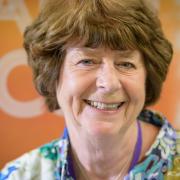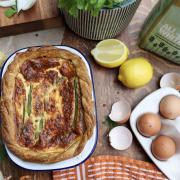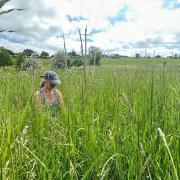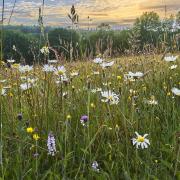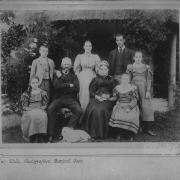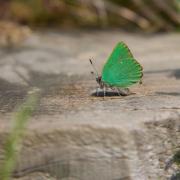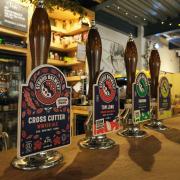The team at Gloucestershire Archives dust off the documents
Photograph of the Month
With the Cheltenham Festival in our minds, this image shows the famous Irish-bred British-trained racehorse ‘Easter Hero’ after winning the 1929 Gold Cup. He subsequently won the 1930 race, becoming the first horse ever to win the race twice and would no doubt have won in 1931 if racing hadn’t been abandoned because of frost. After this 1929 win, the Sporting Life commented that “Easter Hero, in cantering away with the Cheltenham Gold Cup yesterday, gave one of the most sparkling exhibitions of clean, quick jumping and resolute galloping ever seen on this particular course.” He was ridden by Frederick Brychan Rees (always known as Dick), one of the greatest of the inter-war jockeys. He was the first rider to win 100 races in a National Hunt season (1924) and became champion jockey five times between 1920-1927. Easter Hero was owned by John Hay ‘Jock’ Whitney, ambassador, publisher, art collector, philanthropist and investor, Whitney had purchased the horse after the previous owner, the Belgian financier Alfred Loewenstein, was declared dead after mysteriously disappearing from an aircraft over the North Sea on July 4, 1928. Easter Hero was retired in 1931 and went to Whitney’s stud farm in Kentucky. He died there in 1948 and was buried at Whitney’s equine cemetery at Greentree.

Spotlight on Maps
In the late 1600s – over 140 years before racing began at Cheltenham – the Bibury club, an exclusive horse racing club, was holding meetings in the village. Around 1775, with Lord Courtenay, Lord Sackville and General Grosvenor among its patrons, the club laid out a racecourse on the downs east of Aldsworth. The first three-day meeting was held on March 28, 1792 with the main race, the Bibury Sweepstake, being won by Courtenay’s horse, Daisy Cutter. In 1801, a grandstand designed by the architect Richard Pace of Lechlade was built on the site and the following year, the Prince of Wales attended a four-day summer meeting there. Racing continued for the next 30 years, although the club also met at Burford and, between 1830-1835, at Cheltenham. After 1835, regular meetings resumed at Aldsworth until 1848, when racing ceased. By 1881, the grandstand had gone, although some buildings connected with the course remained standing into the early 1900s. Today, cottages in Aldsworth that were originally a jockey’s stable, and a trainer's house are the only reminders of this little racing empire.

Document of the Month
Keeping with the equine theme, this document comes from the minutes of the Gloucestershire War Agricultural Cultivations Committee for November 1918. The ‘War-Ags’ (as they became known) were government organisations tasked with increasing agricultural production during World War 1 (and again in World War 2). They were set-up in Autumn 1915 in a collaboration between the Board of Agriculture and County Councils, with the aim of better managing the country's limited wartime agricultural resources. War-Ags would undertake surveys of rural land in their county, serve orders to farmers requiring them to undertake specific work in specific fields or, if the farmers refused, take possession of the land. Committees could decide on a farmer’s behalf, which crops should be planted in which fields, to increase the production of foodstuffs in their areas. The records produced are fascinating documents that provide information on all aspects of Gloucestershire farming activity including farm inspectors’ reports, details of ploughing orders, the sale of horses, reports of the tractor sub-committee, ploughing up orders and rabbit control orders. This page shows the minutes of the Horse Section of the committee, which was concerned with the numbers of horses in the district of the county, their health and welfare and their employment in farms around Gloucestershire.

Gloucestershire Character
As a lad on my uncle’s farm in the 1970s, the tractors were the stars and horses were a distant memory. Little has changed but, working at the Archives, we sometimes come across images that remind us how important horses were to our county’s agriculture and how great the bond between farmer and animal was – captured beautifully in this photograph. It shows Edward John Smith – known as Ted – with two farm horses. Ted worked at Collum End Farm on Church Road in Leckhampton all his life and didn’t retire until 1939 at the age of 80. This photograph was taken to mark his diamond wedding in 1941 when he went back to the farm to see old friends. Ted married Sarah Ellen Greening at St. Michael’s Church, Bishops Cleeve on November 13, 1881. The couple lived on Pilley Lane where they raised three sons and a daughter. Ted died on July 23, 1945, four years after this photograph was taken, aged 86, and was buried in the churchyard of St. Peter’s Church in Leckhampton. Sarah died two years later aged 77 and was buried alongside her husband on January 29, 1947.
Gloucestershire Archives, Clarence Row, Alvin Street, Gloucester, GL1 3DW, gloucestershire.gov.uk/archives






